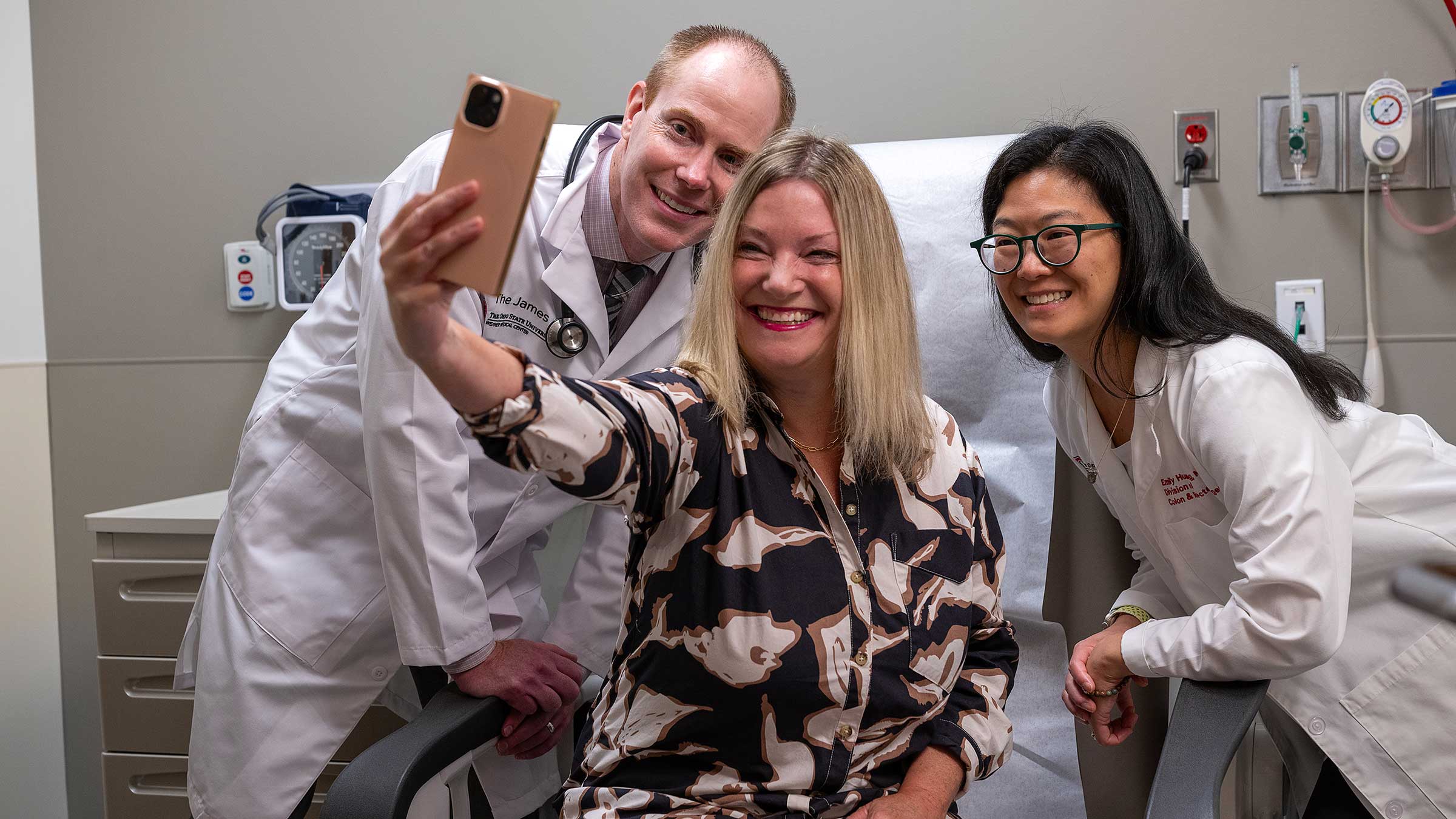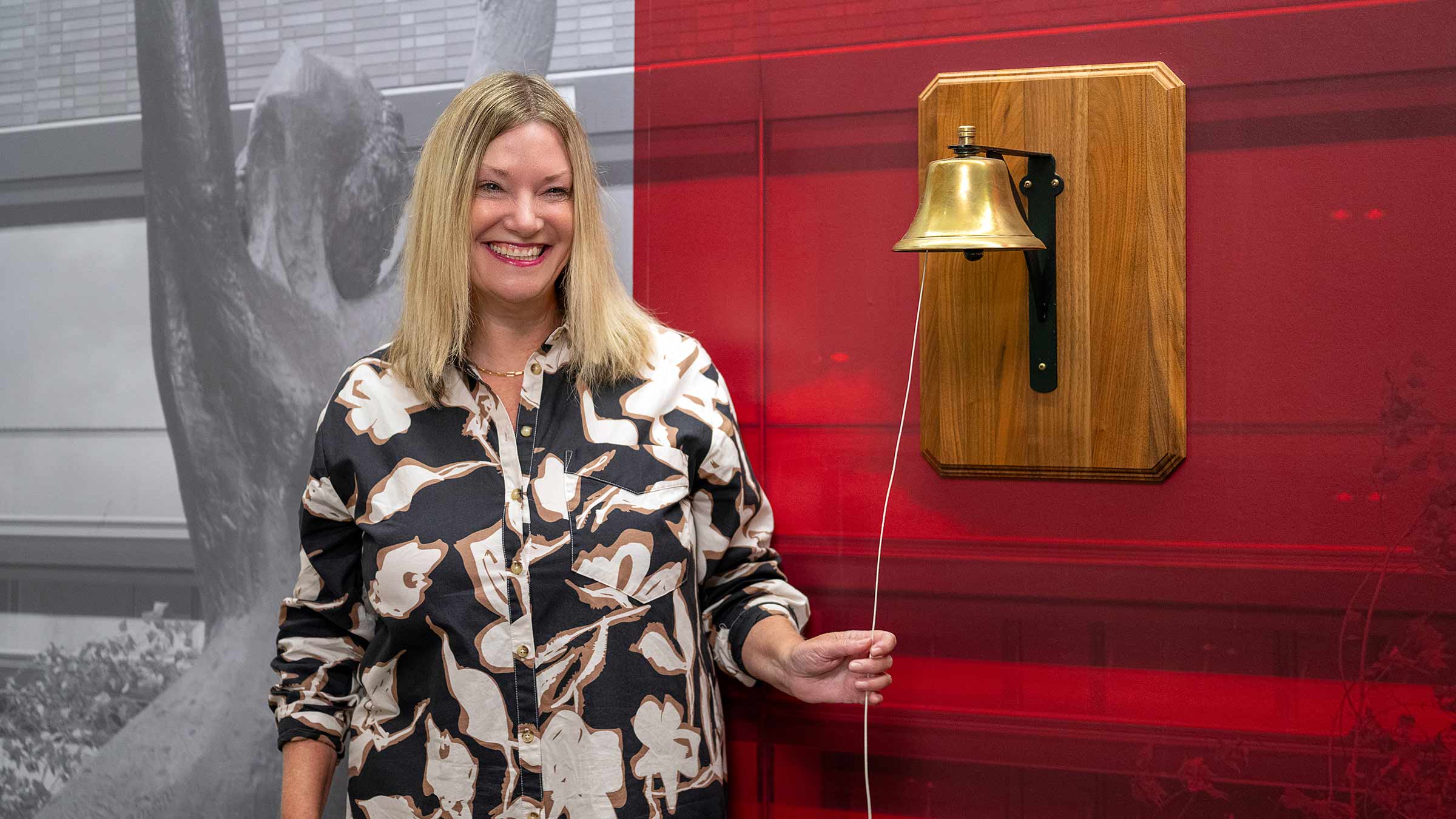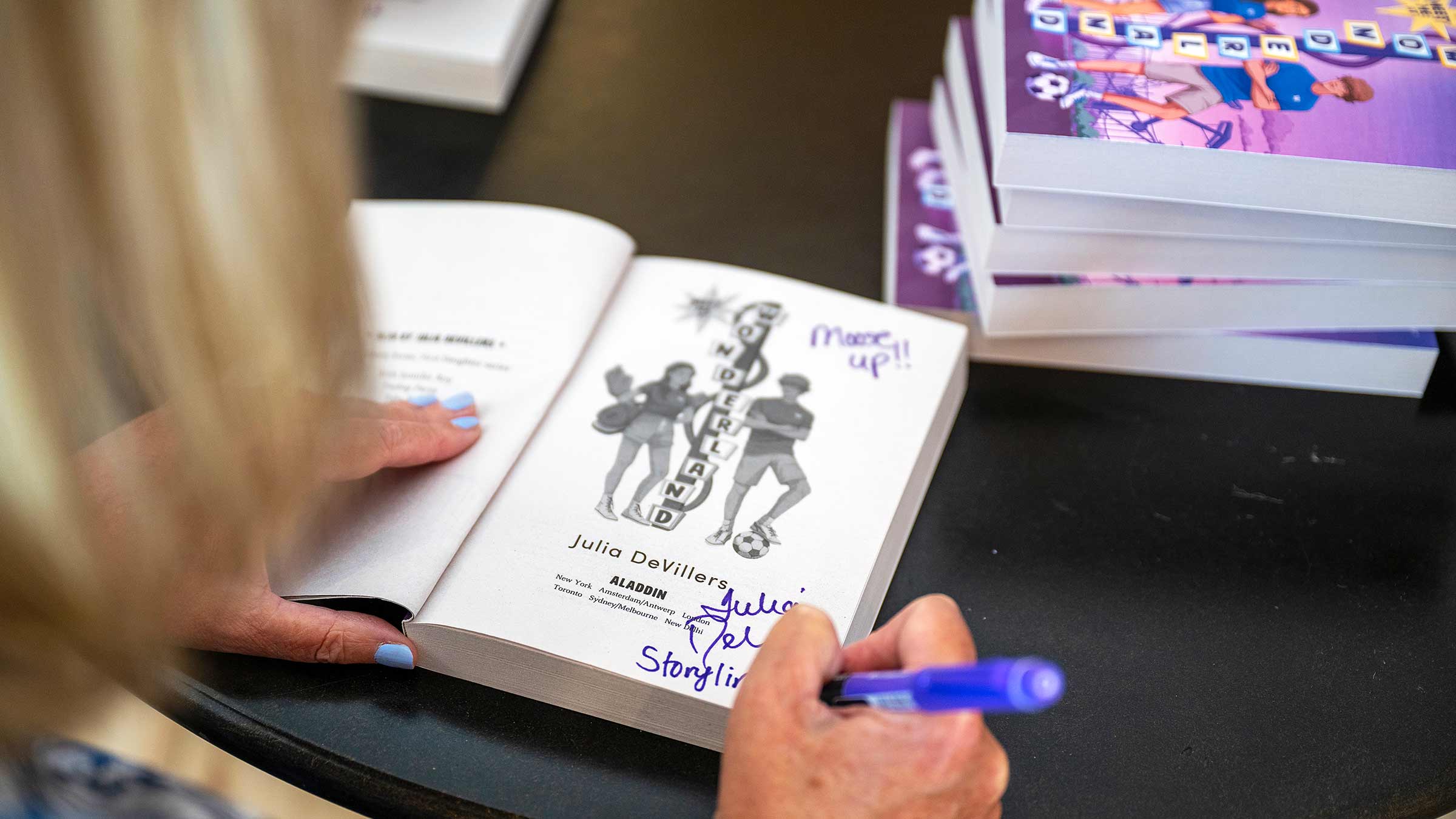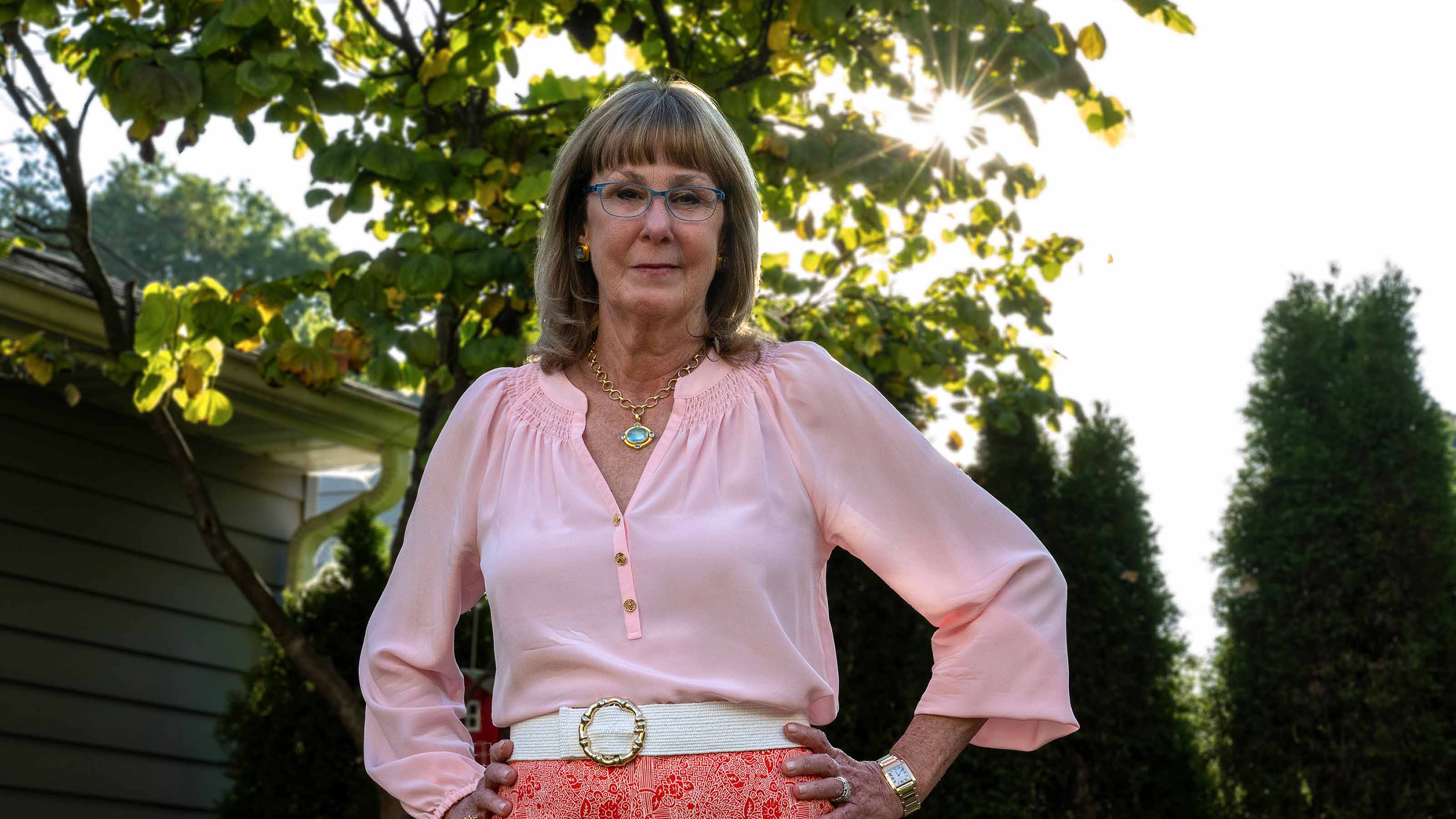Author turns anal cancer diagnosis into opportunity to reduce stigma
Julia DeVillers never wanted to be the face of anal cancer. But she’s using her voice and platform to raise awareness.
When Julia DeVillers was told she had cancer in April 2022, she wasn’t just blindsided by a devastating diagnosis.
She also had to come to terms with a disease she was uncomfortable even talking about.
“At first, I was embarrassed to say it,” says the Columbus-based children’s book author. “I started saying ‘butt cancer.’ I told people I had ‘tush cancer.’ But I didn’t. I had anal cancer.”
DeVillers’ anxiety didn’t end with her diagnosis.
It followed her as she began chemotherapy and radiation treatments at The Ohio State University Comprehensive Cancer Center – Arthur G. James Cancer Hospital and Richard J. Solove Research Institute (OSUCCC – James). And it lingered for months after her treatment regimen, which left her emotionally scarred due to a rare complication that sent her to intensive care for five weeks.
As she healed at home, she hoped to never say the words “anal cancer” again.
Battling anal cancer and stigma
Anal cancer is a rare disease with a stigma that can result in a preventable or curable condition remaining undetected until it’s in late stages, when treatment can be rigorous, says Syed Husain, MBBS, a colorectal surgeon at The Ohio State University Wexner Medical Center and physician lead of the Anal Cancer Screening Clinic at the OSUCCC – James.
“People are really reticent to talk about this area because it’s the anus, and they’re embarrassed,” says colorectal surgeon Emily Huang, MD. “We all have a tendency to try to sweep things under the rug, hoping that covering them will just make them go away.”
In an attempt to battle the stigma while also serving at-risk populations, Dr. Husain led efforts to create the screening clinic, the first in Ohio, in 2023.
“We felt that there was a need for us to have a program that’s welcoming, that’s inclusive, where patients can come in and get the care they need to prevent cancer in an environment that’s nonjudgmental,” Dr. Husain says.
Like DeVillers’ case, more than 90% of the 10,000 cases of anal cancer diagnosed in the United States each year are related to HPV — the human papillomavirus. Two-thirds are in women, many with history of remote genital HPV infection or precancerous cells.
“We see many patients who have remote history of cervical dysplasia or cervical HPV infections, and their physicians were very diligent in taking care of those problems, but because of lack of awareness, they never did anal cancer screening for these women,” Dr. Husain says. “And they now come to us 10, 20 years after, with new development of anal cancer.”

Effective anal cancer treatment and unparalleled support
DeVillers’ ordeal began with an embarrassing symptom she didn’t want to acknowledge — a lot of blood coming from the anal area.
Her doctors initially thought she had a hemorrhoid, and she underwent surgery, and there doctors discovered her cancer. She soon learned it was stage 3.
DeVillers received standard treatment for anal cancer: chemotherapy with daily radiation therapy for six weeks. But she faced a rare complication that wreaked havoc on her digestive system after the chemo resulted in low white blood cell counts.
This is what landed her in the ICU. At one point, her condition became so severe that doctors had her husband and two children and mother come to her bedside in case they had to say goodbye.
Eric Miller, MD, PhD, a radiation oncologist, says while treatment for anal cancer is tough, it’s rare that patients are admitted to the hospital during their treatment.

Even with DeVillers’ complications, he was confident she would pull through and be cured, so he continued her radiation treatments as she was cared for in the ICU, recommending against hospice care when things began to look dire.
“We had specialized care available to take care of her whenever she got really ill,” says Dr. Miller, associate clinical professor of Radiation Oncology in The Ohio State University College of Medicine.
Interrupting or stopping treatment, he said, can result in the return of tumors that are more difficult to treat, so it’s important to stay on course.
“We’ve seen it happen before, and we have the teams in place with the experience to know that there are going to be tough times, but if you manage those issues, support the patients, get them through and finish treatment, all those things will get better, with the goal being to cure the cancer,” Dr. Miller says.
Six months after her treatment, scans and an exam showed the cancer was gone.

Anal cancer screening available for those at risk
Dr. Husain says it’s important not to ignore any symptoms like those DeVillers experienced. Persistent pain, bleeding or a lump in the anal area for more than two weeks warrants a chat with your primary care doctor and, likely, a referral for a screening.
If a screening is positive, current biopsy methods allow physicians to detect precancerous cells and often remove them before they turn into tumors — reducing the risk of developing cancer by almost 60%, says Dr. Husain, a clinical professor of Surgery in the Ohio State College of Medicine.

Current guidelines recommend screening for high-risk people with:
- Compromised immune systems, including people with HIV or people on immunosuppressive medications
- A history of HPV infection, whether cervical, vaginal, anal or oral
- A history of cervical, vaginal or vulvar precancerous lesions (dysplasia) or cancer
- A history of anal intercourse
- Multiple sexual partners
“If you belong to a high-risk population, bring this up to your primary care doctors. Oftentimes, the primary care doctors are not accustomed to this, but that’s why we have a screening program here. We accept all those patients. All you would need is a referral, and we can take it from there,” Dr. Husain says.

Turning trauma into advocacy for HPV-related cancers
In the months after her hospital stay, DeVillers realized that bottling things up wasn’t working.
She started getting requests from friends to talk to others who’d had similar symptoms or had been diagnosed with anal cancer.
Then, a year after her ordeal began, she left the Columbus area for the first time since her diagnosis to fly to Washington, D.C. At the invitation of the HPV Cancers Alliance, she was stumping to raise awareness and advocate for people with HPV-related cancers.
Soon, the author decided to turn to what she knew best: writing. Using her own brand of humor, she penned an essay that further helped her let go of her trauma.
A friend convinced her to share it with Newsweek magazine, and a week later, her story was shared with the world.
“I got responses from people emailing me saying, ‘I had anal cancer,’ or ‘Thank you for sharing this because I have this symptom,’” DeVillers says. “And I thought we obviously have to talk about it because there’s a stigma.”
“Those things made me realize I’ve got a voice. I’m a writer. I can advocate for this so that there’s less stigma. I wasn’t planning to be the face of anal cancer, but I can be,” she says.
DeVillers’ strength shines through her advocacy work, and she has a special sense of humor that’s appreciated in the world of colorectal surgery, says Dr. Huang, an associate professor of Surgery in the Ohio State College of Medicine.
“She took this very difficult thing that she went through and said, ‘Hey, I’m going to make sure that no one else feels afraid to talk about it by telling my story in very, very frank words,’” Dr. Huang says.

Bringing back the joy after anal cancer
In the months after the Newsweek article was published, DeVillers set out to publish something quite different: her first book since her diagnosis. Aimed at a tween audience, it wasn’t about anal cancer, but something taken from her own days as a teenager.
In a way, it also was taken from her days in the hospital. During some of her most difficult moments in intensive care, hallucinations caused by her situation took her back to innocent times: including the time she worked as a teenager at Chuck E. Cheese wearing the mouse mascot costume. She surmises those hallucinations may have been triggered by an Ohio State Brutus Buckeye mascot image she saw during her hospital stay. Her 2025 novel, Meet Me at Wonderland, features a character, Coco, who wears a moose mascot costume at her family’s amusement park, as well as an embarrassing first meeting with co-worker and soon-to-be crush Henry, very much like one that happened to DeVillers when she was in high school.

Also in the novel, Coco’s mom has recently survived cancer.
“I don’t know if you know, but my mom had cancer?” Coco tells Henry in the novel. “… Yeah, she’s in remission now. So it’s all good. … But when she got sick last fall, it was intense. She was in the hospital for weeks.”
DeVillers says the storyline was included, in part, to give her young readers hope.
“The family was affected, but there’s joy and happiness and the mother’s back on top of her game,” DeVillers says. “That’s comforting and it’s hopeful and inspiring, and that’s the part of the story I really, really want people to know.”

Learn more about anal cancer and the treatments available at the OSUCCC – James
Call 800-293-5066 to schedule an appointment.
Learn more




